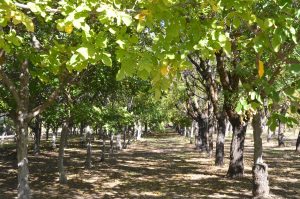Walnut Collection
Jenny Smith, USDA-ARS National Clonal Germplasm Repository, One Shields Drive, University of California, Davis, California 95616
Gayle M. Volk, USDA-ARS National Laboratory for Genetic Resources Preservation, 1111 S. Mason St., Fort Collins, Colorado 80521
John Preece, USDA-ARS National Clonal Germplasm Repository, One Shields Drive, University of California, Davis, California 95616
Outline
1. Introduction
Walnuts belong to the genus Juglans in the family Juglandaceae. The English or Persian walnut, Juglans regia, is the most commonly grown walnut species for nut production. There are about 20 additional species of Juglans that are native to eastern Asia, southeastern Europe, and North America. There are three primary cultivars grown in California: ‘Chandler’, ‘Howard’, and ‘Tulare’. Dependence on primarily three cultivars poses a high risk of genetic vulnerability to pests and diseases; therefore, new cultivars are released almost annually. In 2017, the U.S. produced English walnuts on 335,000 acres primarily in California and had a farm-gate value of $1.8 billion (Juglans Crop Germplasm Committee, 2017; USDA NASS, 2020). The U.S. exports approximately 60% of its walnut nut crop to countries in the European Union, Japan, and Canada (Boriss et al., 2006; Juglans Crop Germplasm Committee, 2017). California’s English walnut industry faces many threats including crown gall, Phytopthora, thousand cankers disease, and nematodes.
Figure 1. Image of English walnut (Juglans regia). Photo credit: USDA Image Gallery.
2. juglans (walnut) collection
The U.S. National Plant Germplasm System walnut collection has 488 accessions representing 10 taxa that are maintained as trees in the field collection. Walnut cultivars are grafted onto rootstocks and wild species representatives are grown from seeds or grafted onto rootstocks.
Figure 2. Trees in the field planting of the U.S. National Plant Germplasm System walnut collection. Photo credit: Gayle Volk.
Video 1. Dr. John Preece discusses the walnut collection.
3. references
Boriss H, Brunke H, Kreith M. 2006. Commodity Profile: English Walnuts. Agricultural Issues Center, University of California.
Juglans Crop Germplasm Committee. 2017. Juglans Vulnerability Statement. USDA Agricultural Resource Service.
USDA National Agricultural Statistics Service (NASS). 2020. Noncitrus Fruits and Nuts 2019 Summary.
4. additional information
Curator: Jenny Smith, USDA-ARS National Clonal Germplasm Repository, One Shields Drive, University of California, Davis, CA 95616-8607, jenny.smith@usda.gov
5. Acknowledgments
Citation: Smith J, Volk GM, Preece JE. 2021. Walnut collection. In: Volk GM, Preece JE (Ed.) Field tour of the USDA National Clonal Germplasm Repository for Tree Fruit, Nut Crops, and Grapes in Davis, California. Fort Collins, Colorado: Colorado State University. Date accessed. Available from: https://colostate.pressbooks.pub/davisrepositoryfieldtour/chapter/walnuts/
This training module was made possible in part by funding from USDA-ARS, Colorado State University, and the United States Agency for International Development (USAID).
Editors: Emma Balunek, Gayle Volk, Katheryn Chen
This project was funded in part by the National Academy of Sciences (NAS) and USAID, and any opinions, findings, conclusions, or recommendations expressed in such are those of the authors alone, and do not necessarily reflect the views of USAID or NAS. USDA is an equal opportunity provider and employer. Mention of trade names or commercial products in this article is solely for the purpose of providing specific information and does not imply recommendation or endorsement by the US Department of Agriculture.




